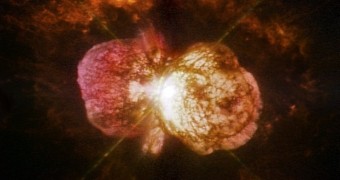With the help of satellites, ground-based telescopes, and one can only presume a whole lot of coffee, NASA astronomers and colleagues managed to put together the most comprehensive picture of a massive binary system dubbed Eta Carinae to date.
Still, scientists stress that, despite having learned plenty about Eta Carinae in recent years, they are yet to reach a full understand of the binary system's history and its occasionally erratic behavior. Hence, they plan to continue studying this cosmic system.
What researchers have so far learned about Eta Carinae
As explained by NASA astronomers, this binary system is located at a distance of about 7,500 light-years from our planet. The reason they were so eager to study it in detail is that it is the brightest and most massive of its kind within 10,000 light-years of Earth.
Eta Carinae comprises two stars that are both bigger than our Sun and that are gravitationally bound to one another. Of the stars that make up Eta Carinae, the brighter, cooler one holds the mass equivalent of 90 Suns. The other, which is considerably hotter, holds about 30 solar masses.
It is estimates that, when compared to our Sun, the bigger star in the Eta Carinae binary system is about 5 million times more luminous. Its smaller companion, on the other hand, is said to produce about 1 million times more light than the Sun.
Researchers say that, once every 5.5 years, the star's orbits bring them strikingly close to one another. More precisely, the stars are merely 140 million miles (225 million kilometers) apart when at their closest approach, known to the scientific community as the periastron.
This distance might sound like a whole lot to us mere mortals, but astronomers say that, in cosmic terms, it's mind-bogglingly close. Thus, the distance between Eta Carinae's stars at periastron is the equivalent of the one between Mars and the Sun.
Both these stars cough out massive amounts of gas in the form of stellar winds. Astronomers say that, in the case of the bigger, brighter star the gaseous outflow originating from it has a speed of about 1 million miles per hour (1.6 million kilometers per hour) and carries one solar mass every 1,000 years.
The hotter star in the Eta Carinae binary system produces a gaseous outflow that carries about 100 times less mass than the stellar wind produced by its companion. Still, its speed is way more impressive. Thus, this other outflow moves at 6 million miles per hour (9.6 million kilometers per hour).
Researchers say that, whenever the two stars get together at periastron, their gaseous outflows end up interacting with one another. Specifically, the fast stellar wind originating from the smaller celestial body carves a cavity in the gaseous outflow coming from its larger, calmer companion.
If you have a few minutes to spare and want to get a better idea of how these stars and the gaseous outflows their produce interact with one another, check out the NASA video below. You'll get to feast your eyes on some seriously impressive space images detailing Eta Carinae's behavior.
Scientists are nowhere near done studying this system
Astronomers with NASA explain that, back in the 19th century, the Eta Carinae binary system went through a rather rough patch and erupted twice. The thing is that, despite having documented these eruptions and the clouds that they birthed, scientists are yet to figure out why they occurred.
Thus, they have so far only managed to determine that, when erupting, the system produced expanding clouds that hold enough mass to produce about 10 stars of a mass similar to that of our Sun. What's interesting is that, by the looks of it, such eruptions might hold clues about the stars' demise.
Scientists claim that a star's mass influences its lifespan. What they mean is that, the more mass a star loses either due to gaseous outflows or because of eruptions, the faster the celestial body stands to run out of fuel and die. The good news is that, for the time being, Eta Carinae does not appear to be dying.
Researchers say that they wish to continue studying this massive, luminous binary system not far from our planet. The end goal of these investigations is to better understand its behavior, maybe even predict what other stunts it could pull in the years to come.
“We are coming to understand the present state and complex environment of this remarkable object, but we have a long way to go to explain Eta Carinae's past eruptions or to predict its future behavior,” NASA astrophysicist Ted Gull explained in a statement.

 14 DAY TRIAL //
14 DAY TRIAL // 